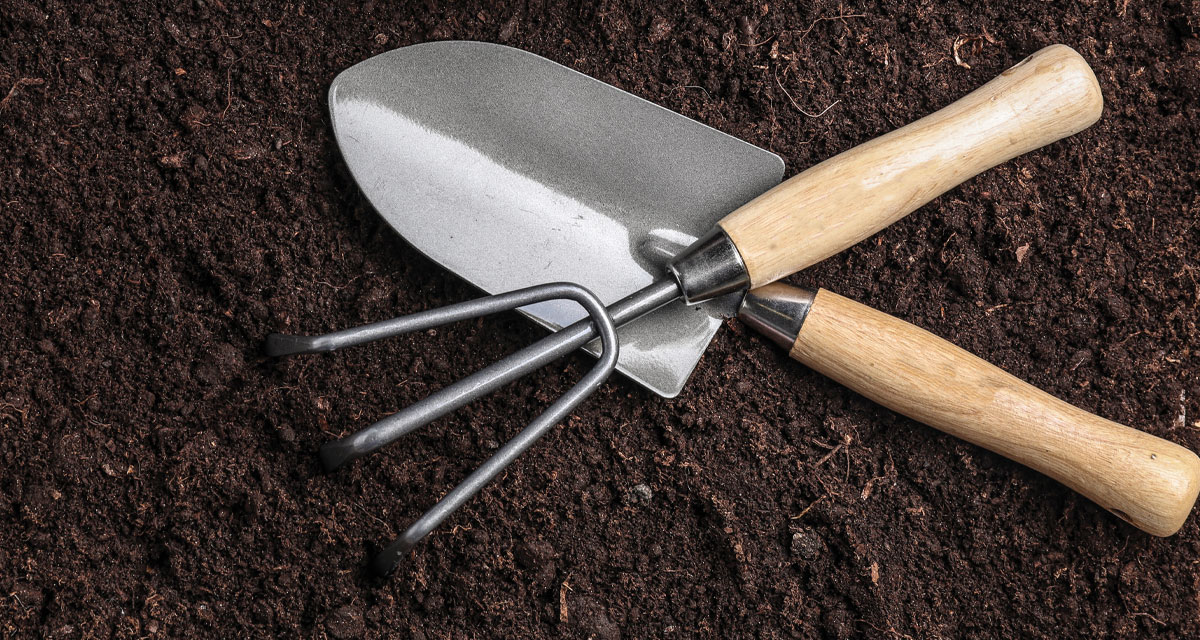Have you ever wondered whether there was a precise formula for garden success? For the garden alchemist, working with soils, fertilizers, and other natural amendments often is an experiment in assessing notes and adaptation. By starting from the building blocks Mother Nature provides, even soil has tests and recipes!
Getting to Know Your Soil
Learning about your soil is the first step towards a healthy and productive garden. You’ll discover, one trowel full of earth will result in varying percentages of sand, silt, and clay. The ideal loam provides 40% equal amounts of sand and silt, and 20% clay. While balancing a plant’s requirement for nutrient retention, this ideal loam offers air pockets, moisture, and drainage.
The next step is to determine your soil type:
- Collect a Soil Sample: In five areas of your garden (consider the corners and center), use a trowel to extract dirt from four inches below the surface. (To avoid altering the pH levels, wear clean gloves.) Mix the contents of the bucket.
- Creating a Home Test: In a one-quart glass jar, fill one-third from the collected sample; then, add water with enough room to shake the contents.
- Results: After 24-hours, assess the four layers appearing as water, clay, silt, and, at the bottom, sand. (Clear water indicates the soil is free-draining sand. Murky water with suspended water leads to loam.)
Testing pH
Measuring your soil for levels of alkaline (0 to 7,) neutral (7), or acidic (7 to 14) can be accomplished at home with a few kitchen items. Just remember, tap water may not provide accurate results.
Apply the following test to the soil sample:
- #1: In a small, clean bowl, add two tablespoons of soil, one tablespoon each of distilled water, and white vinegar. If fizzing occurs, you have alkaline soil.
- #2: Mix two tablespoons in a clean bowl with one tablespoon of distilled water. Add a tablespoon of baking soda and stir. Fizzing results in acidic soil. No reaction equates to a value of seven, neutral.
Potting Soil Recipes
Purchasing bags of soil is an expensive endeavor. The solution is to collect an assortment of unique natural additives and start making your own.
Types of Soil Ingredients:
-
- Ground Bark: Another additive for soil retention, grounded bark allows pockets in the soil.
- Compost: Turn your grass clippings and kitchen scraps into a green source with high nitrogen content, while maintaining the balance by adding carbon by means of leaves, pine needles, shrubbery branches, and shredded newspaper. The “brown” bulk holds moisture and provides airflow. Just add water and aerate! The result will form the foundation for all potting soil recipes.
- Peat Moss, Termed Sphagnum Moss: A primary ingredient in most homemade soil mixes. It contains nutrients and retains moisture. As an acid, amending it with limestone will balance pH levels.
- Perlite: The tiny, white balls of a potted plant is a heated volcanic glass, aiding water retention. Its pH value ranges between 7.0 to 7.5 (alkaline) and it is great for succulents.
- Horticulture Pumice: As a volcanic rock, it is excellent to promote drainage while not retaining water. Because it is heavy, it’s suitable for tall plants that require weight at the base to aid stability.
- Rice Hulls: As a byproduct of agriculture, the sterilized, husked rice hulls add aeration and regulate moisture; and they continue to feed the soil after decomposing.
- Sand: Potting soils benefit from a thin layer of sand to loosen heavy soils or improve drainage for roots penetrating to deeper levels.
- Vermiculite: As a lightweight, mold-resistant, odorless, absorbent mineral, it requires heat to expand. Vermiculite’s pH level is seven, neutral; therefore, it’s safe to add to potting soils and gardens.
Recipes
Using compost takes two steps before it’s ready to use. First, lay it out in the sun for a day to promote sterilization, and screen to eliminate wood chips, sticks, or other weighted items.
- All-Purpose Soil Mix: two parts compost, two parts peat moss, one part perlite, and one-part composted bark.
- Cactus and Succulent Mix: one part compost, one part ground bark, one part sand, and one part pumice.
- Hanging Basket Mix: two parts compost, one part perlite, one part vermiculture, three-tablespoons blood meal
- Raised-Bed Vegetable Mix: four parts compost, one part peat moss, and one part vermiculite.
- Seed Starter Mix: four parts compost, two parts peat moss, one-part vermiculite, and one part perlite.
The All-Purpose Fertilizer
Most nurseries prepare plants with nutrient-enriched soil and water-soluble, slow-release fertilizer. You, too, can add a handful to your all-purpose recipe, ensuring the same benefit of vitamins and minerals to grow steady and robust plants!
Lisa is an NC State Extension Master Gardener Volunteer and State Certified Beekeeper.























